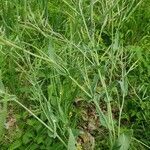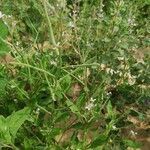Annual herb, erect, usually 10–50 cm high, sparingly branched, glabrous and glaucous. Leaves obovate to elliptic, entire, subsessile to sessile, auriculate and stem-clasping Sepals 5–7.5 mm long. Petals 7–13.5 mm long, somewhat yellow-or green-white. Siliqua cylindrical to quadrangular, 4.5–14 cm long, 2–2.5 mm wide, erect to spreading on pedicels 4–15 mm long; valves with 1 prominent midrib. Seeds ovoid, 2–3 mm long, dark brown to black.
A cabbage family herb. The plant is about 0.5 m high. It is a stout plant and is an annual. The leaves near the base are broadly oval and narrow towards the base. The leaves on the stem are oblong and clasp the stem. They have two rounded ears or lobes near the stem. The flowers have 4 whitish petals. The flower heads are long. The fruit are long angular pods. There are several seeds in a row.


